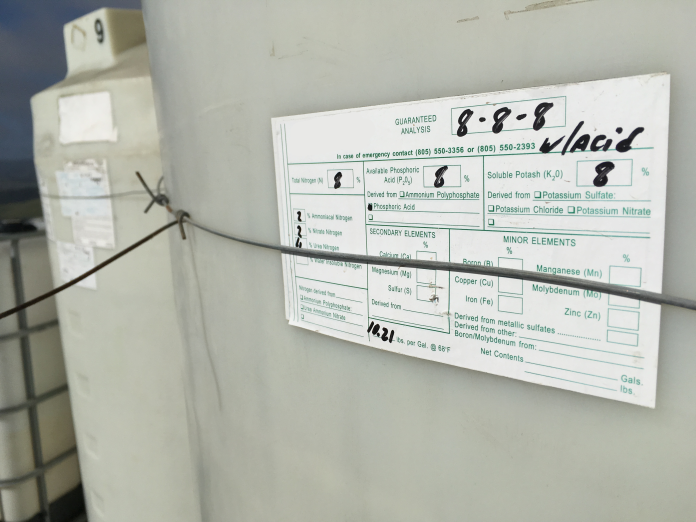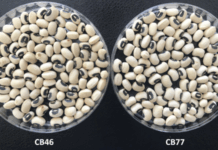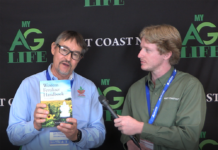The goal of fertilization for any crop is to ensure the optimum levels of nutrients are available to the plant at key stages in the growth cycle. Balancing these factors is an art as well as a science. The first step is identifying what nutrients to apply. The second step is deciding how much fertilizer to apply. The third step is choosing the best time to make the application.
Tissue Analysis
In an ideal world, all of the plant’s needs would be met by nutrients available from the soil. In wine grapes, however, soil tests are not a useful predictor of fertilizer needs as the vine’s uptake of nutrients is affected by soil chemistry such as pH and the dynamics of different soil types. Therefore, tissue analysis in the forms of leaf blade and petiole analysis are required. Tissue should be sampled twice per year. Bloom time petiole analysis describes the vine’s nutritional needs during the growing season. Tissue sampling at early veraison is useful for making decisions about macronutrient adjustments postharvest as nitrogen, phosphorus and potassium are all mobile in the vine between harvest and leaf fall.
Bloom time tissue analysis provides a good picture of shortages in micronutrients such as zinc, magnesium and boron. Leaf blades and petioles are separated and analyzed separately. For bloom time sampling, leaves should be selected opposite the first cluster, ideally at 50% bloom. When sampling at veraison, select the most recently matured leaf — usually the fifth or so leaf from the tip. The most important things to consider are sampling at the same time each year and accurately reflecting variation within the block.
Tissue analysis results need to be interpreted in the context of other information. Are vines exhibiting symptoms of a nutrient deficiency or excess? What is the overall vegetative growth of the vine? Is fruit set less than desired or uneven? Nutrient deficiencies are relatively easy to spot, but not always easy to diagnose. Tissue analysis will identify or confirm what those deficiencies are. Assessing vegetative growth is relatively easy. These data are only meaningful when compared year to year, so several years of data collection may need to be conducted before the relationship between fertilizers applied and their effects can be identified.
Therefore, record keeping is an important part of making fertilizer decisions. Information including tissue analysis and fertilizer applications from previous years provide insight into how in-season and post-season fertilizer applications affected nutrient status over time. Data on pruning weights and estimates of canopy growth at bloom can also show trends suggesting whether too much or too little nitrogen is being supplied.
Fertilizer Rates
As every vineyard and every block within a vineyard is different, the only way to accurately (i.e. efficiently) determine amounts of nutrients to apply is to adjust published ranges for the deficiency or excess of nutrients based on personal experience. Translating tissue analysis results into specific amounts of fertilizer to apply is not an exact science. Differences in soil can have a sizable impact on nutrient uptake and, therefore, fertilizer requirements between areas. Consider flagging rows or using GPS coordinates to sample the same areas. Year to year comparisons will tell you if your fertilizer decisions are accurate and effective.
Nitrogen and potassium are the primary nutrients that need to be supplied with fertilizers, although phosphorus and calcium are also important. Both have downsides if oversupplied, however. Excess N results in excessive growth and overcropping while excess K yields an unacceptably high pH in the juice at harvest. Replacing minerals is very important as they are transported off-site in the crop and not recycled back into the soil like leaves or canes. Every situation is different, but believable ranges are 3 to 5 pounds N, 5 to 8 pounds K, and 1 to 2 pounds Ca are removed from the vineyard each year. Most of these nutrients are taken up by the vine during the postharvest period if they are available.
Grapevines are composed of 1 to 2% N. 30% of N that the vine uses is taken up during the period between harvest and leaf fall. The same is true for K, although the rate of uptake drops off dramatically about a month after harvest. N is an important requirement for the production and function of proteins and is a major component of chlorophyll. Wine grapes will consume 40 to 50 pounds N per acre during the growing season. Much of this will be returned to the soil in the form of prunings and leaves, but the breakdown of pruning wood into bioavailable forms of N takes years, and much may be lost as nitrous oxide during the process. N is released from soil organic matter at the rate of approximately 20 lbs/acre/percent organic matter. Therefore, on soils with less than 2% organic matter, the rate of N provided through fertilization should be increase by 10 to 20%. On soils with greater than 3% organic matter, consider reducing the amount of N delivered. Nitrate levels in irrigation water can be meaningful contributors to total N supplied to the vine. In some areas of California, nitrate levels are high enough that they could be considered fertilizers.
Rates of N application in wine grapes vary from 0 to as much as 60 pounds per acre per year. Making decisions about the rate of nitrogen fertilizer to apply is complicated as excessive applications can result in nitrates leaching into groundwater and/or the generation of the greenhouse gas nitrous oxide. In leaf blades at bloom time, less than ~2% total N is considered deficient. N deficiency is expected with levels less than ~1.5% in leaf blades at veraison.
K uptake is negatively affected by high magnesium in the soil. Therefore, even if K is plentiful in the soil, additional K may need to be provided to avoid deficiency. K levels are deficient below 1% in both petiole and leaf blades during the spring and ~0.7% in the fall. A reasonable target is 2 to 3%.
Timing Application
N may be applied in a split application, with half being applied just after berry set and the other half being applied postharvest. In-season applications of N may not be necessary at all depending on the results of tissue analysis. This is an especially important consideration given that too much N in the vine during the growing season can result in excessive growth, shading inside the canopy and higher disease incidence. To avoid this, spoon feeding vines during the growing season can afford more control.
The goal of postharvest fertilization is to deliver N, K and Ca to the root zone during a time when the vines will take up the nutrient and store them in the trunk so that they are available when the vine breaks dormancy and the demand for these nutrients is the highest. For example, one study found that 50% of N in the canopy comes from N which had been stored in the trunk and roots of the vine. Timing is critical. Too soon and N may kick off a new flush of growth and delay dormancy. Too late and the vine is no longer moving water into the trunk. The canopy needs to be healthy and functional. Hitting this window with late ripening varieties may be difficult, especially if a frost knocks the leaves off. Also, care must be exercised in cold areas because excessive N postharvest can cause hardiness issues. Fertigation is the preferred method of delivering N and K fertilizers as foliar applications can result in an overly rapid uptake. Also, there needs to be sufficient soil moisture for vine roots to take up the elements.
The amount of time required for vines to restore their carbohydrate and mineral reserves varies by crop load. Vineyards with a crop load of 2 to 4 tons per acre need very little time to recover and restore after being harvested. Vineyards in the 4 to 8 tons per acre range require about a month for restoration. Vineyards cropped above eight tons per acre need between 4 and 8 weeks to build their reserves back up.
A Note on Compost
A grower may want to apply compost to their vines for multiple reasons, including delivering nutrients, inoculating the soil with microbes, increasing soil organic matter and improving soil structure. When using compost as a fertilizer, one must know the chemical analysis of the material and take into account the range of nutrients compost will contribute to the vine, including but not limited to P and K. Good quality, finished compost will have a C:N ratio of less than 20:1. Of the total N per ton in the compost, about 30% is available to the vine. Of that, approximately half is available the first year after application, with the remaining N becoming available over the next three to four years.
Although grapevines can survive in depleted soils, maintaining adequate crop loads and vine health requires replacing the elemental nutrients removed in fruit and to account for the long time required to recycle N and K from prunings and leaves back into the soil. A successful fertilization program provides enough of the required elements without producing excessive growth, high juice pH or generating pollution. Scientific data and historical records combined with experience can achieve the goals of the fertilizer program.
Thanks to Dan Rodrigues of Vina Quest LLC for his contribution to this article.















